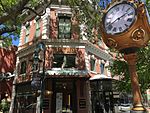First National Bank (Columbia, South Carolina)
Bank buildings on the National Register of Historic Places in South CarolinaBuildings and structures in Columbia, South CarolinaColumbia, South Carolina Registered Historic Place stubsColumbia, South Carolina building and structure stubsCommercial buildings completed in 1924 ... and 2 more
National Register of Historic Places in Columbia, South CarolinaNeoclassical architecture in South Carolina

First National Bank, also known as the National Loan and Exchange Bank Addition, is a historic bank building located at Columbia, South Carolina. It was built about 1924, and is a two-story, stone faced Neoclassical style building consisting of a two-story central section with flanking one-story wings. The front façade features four monumental 3/4 detached Doric order columns.It was added to the National Register of Historic Places in 1980.
Excerpt from the Wikipedia article First National Bank (Columbia, South Carolina) (License: CC BY-SA 3.0, Authors, Images).First National Bank (Columbia, South Carolina)
Main Street, Columbia Main Street District
Geographical coordinates (GPS) Address Nearby Places Show on map
Geographical coordinates (GPS)
| Latitude | Longitude |
|---|---|
| N 34.003611111111 ° | E -81.034444444444 ° |
Address
National Loan and Exchange Bank Building
Main Street 1338
29203 Columbia, Main Street District
South Carolina, United States
Open on Google Maps










